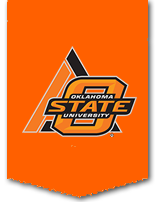OKCRA displays new products and dishes at formal dinner
By Mandy Gross
FAPC Communications Services Manager
5-12-2008
STILLWATER, Okla. – Emeril Lagasse, Rachael Ray and Paula Deen have nothing on the members of the Oklahoma Culinary Research Alliance, or OKCRA. In fact, they would be jealous.
OKCRA, a joint collaboration between the Robert M. Kerr Food & Agricultural Products Center and Oklahoma State University Institute of Technology–Okmulgee Culinary Arts Program, unveiled new products and dishes during a formal dinner held on the Okmulgee campus.
The collaboration was designed to advance value-added products from processing to presentation, said Andrea Graves, FAPC business planning and marketing specialist and OKCRA chair.
“The dinner was a chance to showcase what the OKCRA team has been working on for the past several months,” Graves said. “The OKCRA team has worked extremely hard in developing new products from underutilized raw materials that are not yet available in the food industry.”
The first project addressed by OKCRA was to enhance and facilitate the movement from commodities to value-added products in the beef industry, said Jake Nelson, FAPC value-added meat processing specialist.
“The beef industry, in part with the Beef Checkoff, is currently investigating methods to bring additional value to the beef chuck,” Nelson said. “Multiple sectors of processing industries could benefit from new or novel methods of fabrication, further processing and final preparation for the consumer.”
OSU Institute of Technology–Okmulgee developed a culinary class to fulfill the objectives for the beef project. Chef Scott Sherrill, culinary arts faculty member and instructor of the class, and his students— Kevin Sloan, Josh Lee, Danny Savala, Kelvin Williams and Kristen Anderson—applied innovative approaches to the beef chuck.
The top 10 culinary techniques applied during the semester were showcased on never-before-used beef chuck muscles during the dinner. Some of the methods included stewing, braising, roasting, broiling and smoking.
“Participants saw what we feel are the best and most innovative approaches to add value to a traditional commodity beef cut,” Sherrill said.
The students set up action stations for each of the products displayed. Participants had the opportunity to visit each station to fill their plate and discuss with the students the techniques used on the beef cuts.
Representatives from various sectors of the food industry attended the dinner to hear more about OKCRA and see the unveiling of the new products.
John Williams, president of Chef’s Requested Foods in Oklahoma City and participant of the dinner, said he was impressed with the beef cuts, and he believes that most of the other participants were impressed as well.
“The ability to take what’s developed at the FAPC, such as ingredients and processes, and execute them into presentation is a great way to expedite new products to foodservice,” Williams said. “The project is an intriguing brick that’s been laid for a brighter future for us in the beef industry.”
After attending the dinner and seeing the different beef cuts, Williams requested a beef cutting demonstration for his key employees who would benefit from this knowledge.
Even though the spring semester and the culinary class have concluded, the OKCRA team is still finalizing work on the beef project. Several information sheets, or Product Profiles, will be developed as marketing tools in the food manufacturing and foodservice industries in Oklahoma.
Also, Sherrill gave a presentation about the OKCRA program and results of the beef project to the National Cattlemen’s Beef Association’s Beef Innovations Group, or BIG, which is funded by the Beef Checkoff. BIG held its annual meeting at the FAPC in April to ensure the group is meeting its strategic goals and make plans for the upcoming fiscal year.
For more information about OKCRA, call Graves at 405-744-6071 or e-mailandrea.graves@okstate.edu.
- ### -
Oklahoma State University, U.S. Department of Agriculture, State and Local Governments Cooperating. The Oklahoma Cooperative Extension Service offers its programs to all eligible persons regardless of race, color, national origin, religion, sex, age, disability, or status as a veteran, and is an equal opportunity employer.

